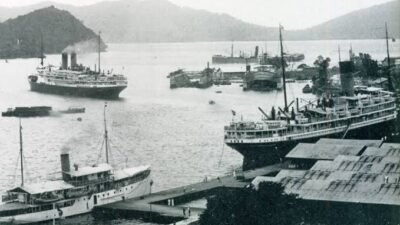By: Iskandar Bakri – Aceh Business Network
Abstract
The Sabang Free Port once played a crucial role in the economic and social development of Aceh, functioning as an international trading hub that connected the region to global markets. Its closure under Indonesia’s New Order regime in the 1980s represented not only the termination of an economic opportunity but also a political strategy to consolidate central authority. This article examines the closure of Sabang Free Port, focusing on the legal case of Mayor M. Yusuf Walad as a scapegoating mechanism, and situates the event within the broader context of Aceh’s political marginalization. The analysis highlights how the port’s closure contributed to long-term grievances that fueled the rise of the Free Aceh Movement (GAM).
Keywords: Sabang Free Port, New Order, Aceh, political marginalization, GAM, Indonesia

The political history of Aceh is deeply intertwined with its economic position within Indonesia. Sabang Free Port, established as a free trade zone in the early 1970s, provided Aceh with access to goods and technologies that were not yet widely available in the rest of Indonesia. For many Acehnese, the port symbolized a period of economic prosperity and global integration (Hasjmy, 1994).
However, by the late New Order period, the central government abruptly closed the port. This decision is widely regarded not only as an economic policy but as a politically motivated act intended to suppress local autonomy. The consequences extended far beyond trade, intensifying Aceh’s distrust toward Jakarta and contributing to the rise of separatist sentiment.
Politicization of Law: The Case of M. Yusuf Walad
The closure of Sabang Free Port coincided with the prosecution of Sabang’s Mayor, M. Yusuf Walad, MBA, who was sentenced to more than 14 years in prison on charges of corruption. Many accounts suggest that the charges were exaggerated, if not fabricated, as a way to delegitimize local leadership and provide justification for dismantling the free port system (Ali, 2007).
The case exemplifies the instrumentalization of law under the New Order, where legal institutions functioned less as mechanisms of justice and more as tools of political control (Lev, 1990). By targeting Yusuf Walad, the regime not only removed a prominent local figure but also signaled to Acehnese elites that defiance of central policies would be punished severely.
Socioeconomic and Political Consequences
The closure of the port had immediate and long-term effects. Economically, Aceh lost its gateway to international trade, reducing both state and community revenue streams. Socially, the closure marked the end of what many considered the “golden era” of Aceh’s modern commerce, producing collective disillusionment (Zainuddin, 1999).
Politically, the event reinforced perceptions of central exploitation. The Acehnese had long viewed their region as marginalized despite its contribution to national revenue through natural resources, especially oil and gas (Aspinall, 2009). The dismantling of Sabang Free Port thus became another symbol of Jakarta’s disregard for Aceh’s economic rights and political autonomy.
Linkages to the Rise of GAM
The emergence of the Free Aceh Movement (GAM) in 1976 can be seen as part of a broader historical trajectory of Acehnese resistance. While GAM’s founding was primarily motivated by resource exploitation and central neglect, the closure of Sabang Free Port added a powerful narrative of betrayal and injustice.
By eliminating one of Aceh’s key economic institutions and scapegoating its local leadership, the New Order inadvertently provided GAM with further legitimacy in its claim that Jakarta systematically undermined Acehnese sovereignty (Schulze, 2004).
Conclusion
The closure of Sabang Free Port illustrates the nexus between economic policy and authoritarian political strategy under Indonesia’s New Order. Far from being a mere fiscal or administrative decision, it represented a deliberate attempt to weaken local autonomy while consolidating central authority.
The scapegoating of Mayor M. Yusuf Walad demonstrated how law could be weaponized for political ends. The resulting economic dislocation and political resentment deepened Aceh’s historical grievances, providing fertile ground for the rise of GAM and the prolonged conflict that followed.
Understanding the closure of Sabang Free Port is thus essential not only for analyzing Aceh’s past but also for drawing lessons on the importance of justice, autonomy, and inclusive governance in post-conflict reconstruction.
References
Ali, H. (2007). Aceh dalam Pusaran Politik Orde Baru. Banda Aceh: Pustaka Aceh.
Aspinall, E. (2009). Islam and Nation: Separatist Rebellion in Aceh, Indonesia. Stanford University Press.
Hasjmy, A. (1994). Sejarah Kebudayaan Aceh. Jakarta: Bulan Bintang.
Lev, D. S. (1990). Legal Evolution and Political Authority in Indonesia. Leiden: KITLV Press.
Schulze, K. E. (2004). The Free Aceh Movement (GAM): Anatomy of a Separatist Organization. Washington DC: East-West Center.
Zainuddin, H. (1999). Sabang: Sejarah dan Harapan Ekonomi. Banda Aceh: Yayasan Pena.


